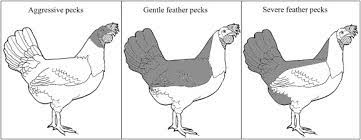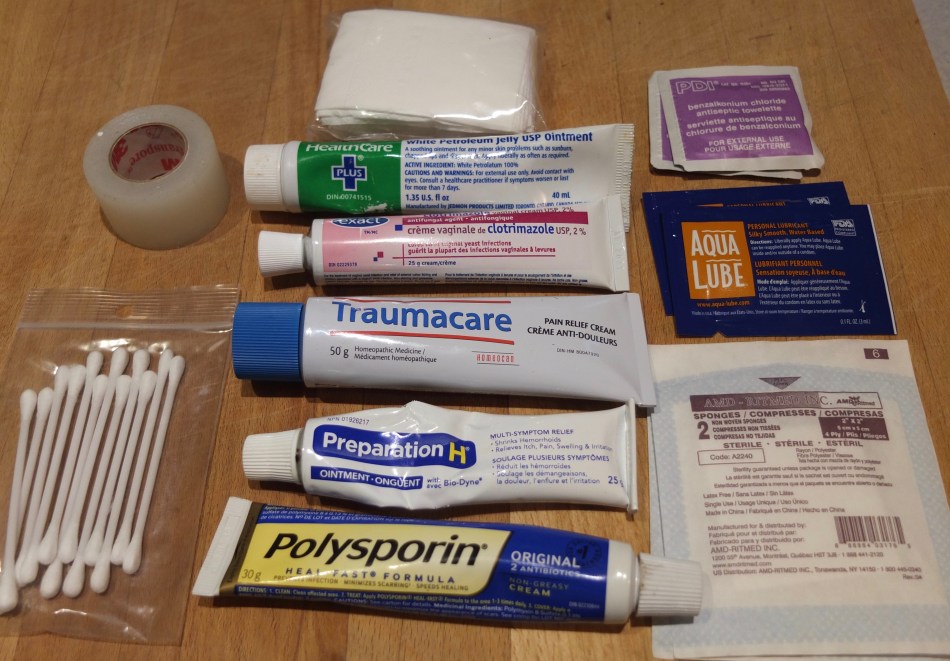Pecking is synonymous with chickens: from the time they hatch when they start exploring the world with their beaks, to foraging in the ground for food to using their beaks to continually reinforce the flock hierarchy. If you’re new to chickens it’s a bit disturbing to see how often they peck each other throughout the day. Most of that behaviour is not intended to cause harm but to regulate their social structure.
That said, they can, and do wield their beaks to cause significant damage and death: hens kill their struggling chicks, newcomers, sick birds and anything with the presence of blood. Of course, prevention is always best, but sometime pecking injuries happen when you least expect them or are unprepared for the savagery of our feathered friends.

For all you folks that have fallen victim to chicken math I’ve read that the critical maximum number for a stable hierarchy is 30. A small flock engenders relationships and recognition between members. More than that means there are likely to be conflicts, potential competition or overcrowding. The greatest stressor for chickens are moving into or out of a flock and having new members added to a flock.
In 2014 I bought a group of bantam chickens: a pair of Black Breasted Red Old English Game (OEG), their two 6-week old daughters, a 10-week old Silver Duckwing OEG pullet and a bantam Ameraucana pullet. I had to buy the group as a package: I didn’t want another rooster, but I had friends who wanted a breeding pair of bantams so I organized a new home for them.
When they came home I put them all in a large dog crate. The next day, my friend picked up the OEG adults. What I didn’t realize was once the parents were gone there were no mediators for any potential conflicts. The four remaining birds had more space, and although there wasn’t a big difference in size between the younger OEGs and the Silver Duckwing, a pecking order was being established – literally.
I discovered that the older pullet had pecked one of the smaller pullets quite severely. She had a gaping wound, exposing the whole back of her skull and I wondered if she would survive.
I brought my young pullet into the house to do some emergency first aid. Just looking at the wound made me feel squeamish. There was no flap of skin to put over her skull. My partner held her while I cleaned the wound and applied polysporin and Vetericyn spray and covered it with a tiny square of gauze. We then tied a narrow strip of gauze, knotting it to keep the compression pad in place. I couldn’t return her with the others so she went into our bathroom in a small dog crate. I brought her sister in to keep her company and they got along fine.
For several days, I removed the gauze pads (at first it stuck to her scalp and I had to moisten it to work it away from the wound), put on more polysporin, Vetericyn and a new bandage. In hindsight, I wouldn’t use the pad – it did protect her open wound, but it was difficult to remove in order to reapply the antibiotic ointment.
This has been my only experience with pecking. The wound was major, but fairly straightforward in terms of treatment. Never having dealt with bullying before, I learned not to assume that if birds were familiar with each other there wouldn’t be any issue housing them together.
Transporting and changing environments is stressful for birds and that can result in bullying. If I hadn’t intervened I have no doubt that any further damage to the little pullet would have killed her. If I have been more prepared and monitored them more closely I might have been able to prevent her pecking injury.
First Aid Strategies
In any case of bullying or pecking the first thing is to remove the victim in order to assess and treat any injuries. You might be dealing with multiple or deep wounds, the loss of eyes or vent pecking leading to the exposure of internal tissues.
- The first 24 hours are critical for shock.
- Rinse blood away with warm water or saline solution.
- Apply Blood Stop powder or cornstarch to stop bleeding.
- Use a syringe to flush out dirt or to irrigate a deep wound.
- Apply an antibiotic or antiseptic cream/spray.
- Give ½ tablet of 81mg baby aspirin to an adult sized bird for pain relief.
- House in a safe quiet space (i.e. dog crate away from flock).
- Provide fresh water and food. Staying hydrated at this point is more important than eating.
- Monitor for infection. Antibiotics may be required from your veterinarian.
- If the patient is not making progress towards healing consider euthanasia.

It is critical to assemble a well-stocked first aid kit with supplies for pecking and predator injuries:
- Betadine, polysporin, neosporin and/or 2% Chlorhexadine
- Traumacare cream, Traumeel homeopathic pellets, Rescue Remedy spray
- Vetericyn spray
- Gauze pads (stops bleeding)
- Electrolytes (given for the first three days only)
- Blood Stop powder or cornstarch
- Pain management (½ 81mg baby aspirin – adult dosage)
- Syringes (flushing dirt from a wound)
- Saline solution (rinsing wound)
- Vetrap, non-stick wrap
Reintroduction
In my case, I re-homed the bully while my patient was convalescing and there were no issues integrating her (and her sister) into my flock. The bully was fine in her new home. I attribute the pecking to stress from transport and being confined to the crate.
In most cases the victim will be returning to the flock with the bully (or bullies). You need to assess the reasons for the incident and if, and when, it is safe to return the injured bird. Never reintegrate a bird until the injury is healed and there is no evidence of blood. You can remove the main instigator to a crate for the duration that the victim is in the infirmary. Try a side-by-side introduction with the victim first and if all goes well a supervised integration as though you were adding a new member to the flock. Return the bully later in the hope that the pecking order has been readjusted. If the pecking continues install pinless peepers on the aggressor or re-home either bird for the victim’s safety.

Prevention
Pecking is often triggered by stress so the key is to minimize stressors:
- Changes to the flock
- Overcrowding
- High or low temperatures (especially heat stress)
- Competition over food or water (have multiple stations)
- Boredom
- Too much, or too little, light
- Poor nutrition
- Remove ill birds that might become a target
- Pecking often occurs when new birds are moved into an existing flock. Do a gradual, supervised integration and never put young chicks into an adult flock unless they are with a hen (and even then, be careful). Sadly, this is what happened to this chick whose head and eyes were pecked, then became infected and had to be euthanized.





Thanks for the feedback.
LikeLike
How is your chicken now? We found one of our severely pecked yesterday and it’s heartbreaking. Our chickens are my daughters pride and joy and she is devastated. We have it seperated inside in our brooder and have applied polysporin after cleaning with water. We will apply the anti microbial spray today as well. I’m curious how your chicken recovered? Our chicken seems off balanced and I’m sure in shock.
LikeLiked by 1 person
My pullet totally recovered, no issues except a scar on the back of her head that never feathered. Surviving shock is a big first step. Keep her warm, quiet and hydrated. Chickens are amazingly resilient.
LikeLike
Thank you! Do you have an email where I could exchange information and ask some questions.
LikeLiked by 1 person
Click on the contact button (top right-hand side, just under Bitchin’ Chickens on the home page) and that will connect you to my email.
LikeLike
A trick we have done when introducing younger birds was to introduce them over the fence (so they could see each other b not attack) then when we fully integrated younger ones we made sure they had spots to hid in that bigger hens could not follow. We also got more new chicks than we really needed (8) thinking having more young ones means older hens (15 of them) even if aggressive would not gang up on 2 chicks but spread their bad behavior across more youngsters. It worked out really well. Sure there was some fighting but no injuries as they figured out a new order pretty fast.
LikeLiked by 1 person
I dealt with a mild pecking situation recently. I had (4) 4 week old chicks together (a Rhode Island Red, a Buff Orpington, a Lavender Orpington, and an Easter Egger) and I noticed that my EE was a bit bloody on the side of her neck and saw one of the girls pecking at it. Thankfully, I caught it early and was able to reintroduce her in just 2 days and all was fine.
They are now 7 weeks old and I have (7) 3 week old chicks. My set up has been a 3×4 diy brooder box divided in half with hardware cloth with littles on one side full time and big girls on the other when I bring them in at night. My big girls are about to be in their coop full time in the next week. My question is, how should I go about introducing the little ones out there when it’s time for them to move out? Will the all remember each other from their time in the brooder? Should I put them in a dog crate in the run during the day for a bit?
LikeLiked by 1 person
I think chickens have pretty short memories so I’d do a side-by-side integration first. A dog crate will work with the coop or run will work. When that seems ok then do a supervised integration to monitor there is no real bullying and pecking. It helps if you have a place for the littles to hide or get away from the others. Check out the post “Adding To Your Flock” for more information.
LikeLike
You know, I appreciate that you share your challenges with us & admit where there’s room for improvement. A lot of folks that create content seem to know it all & act like everything’s just perfect with their flocks all the time.
It’s when we experience something that we’ve never gone through before, that we can really learn and reevaluate if necessary. Sharing that information with others, so that they don’t have to learn the hard way, well, I’d say that’s turning lemons into lemonade
LikeLiked by 1 person
That’s a great way to look at it.
LikeLike